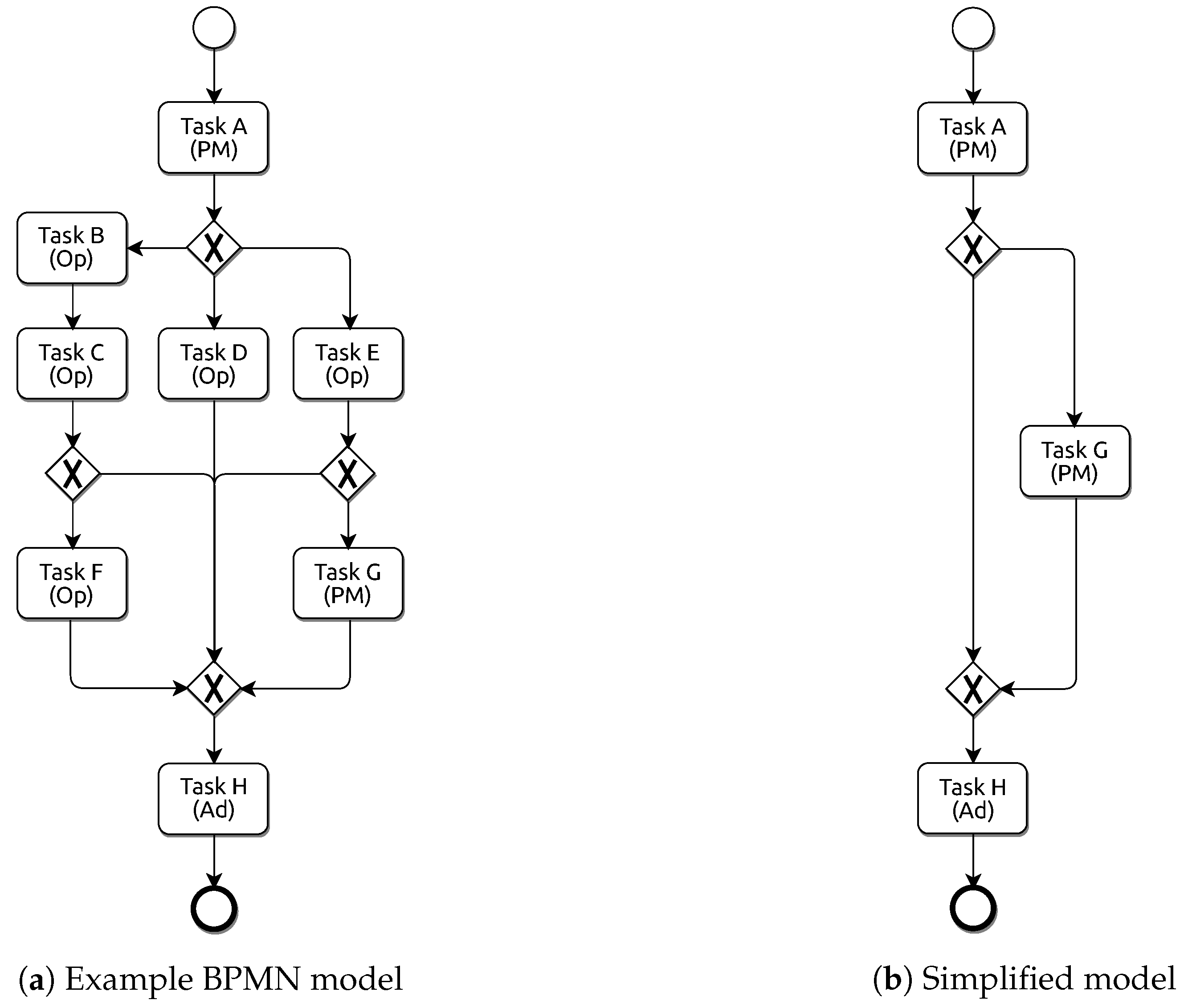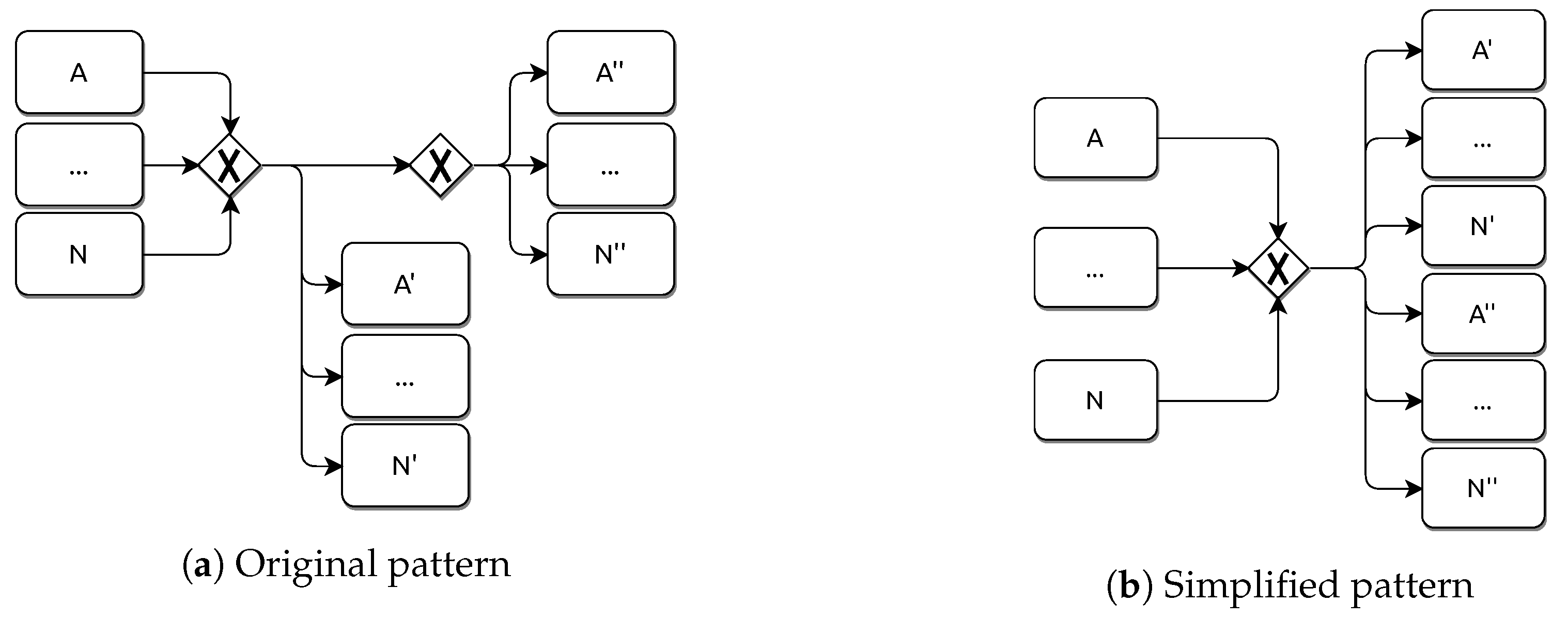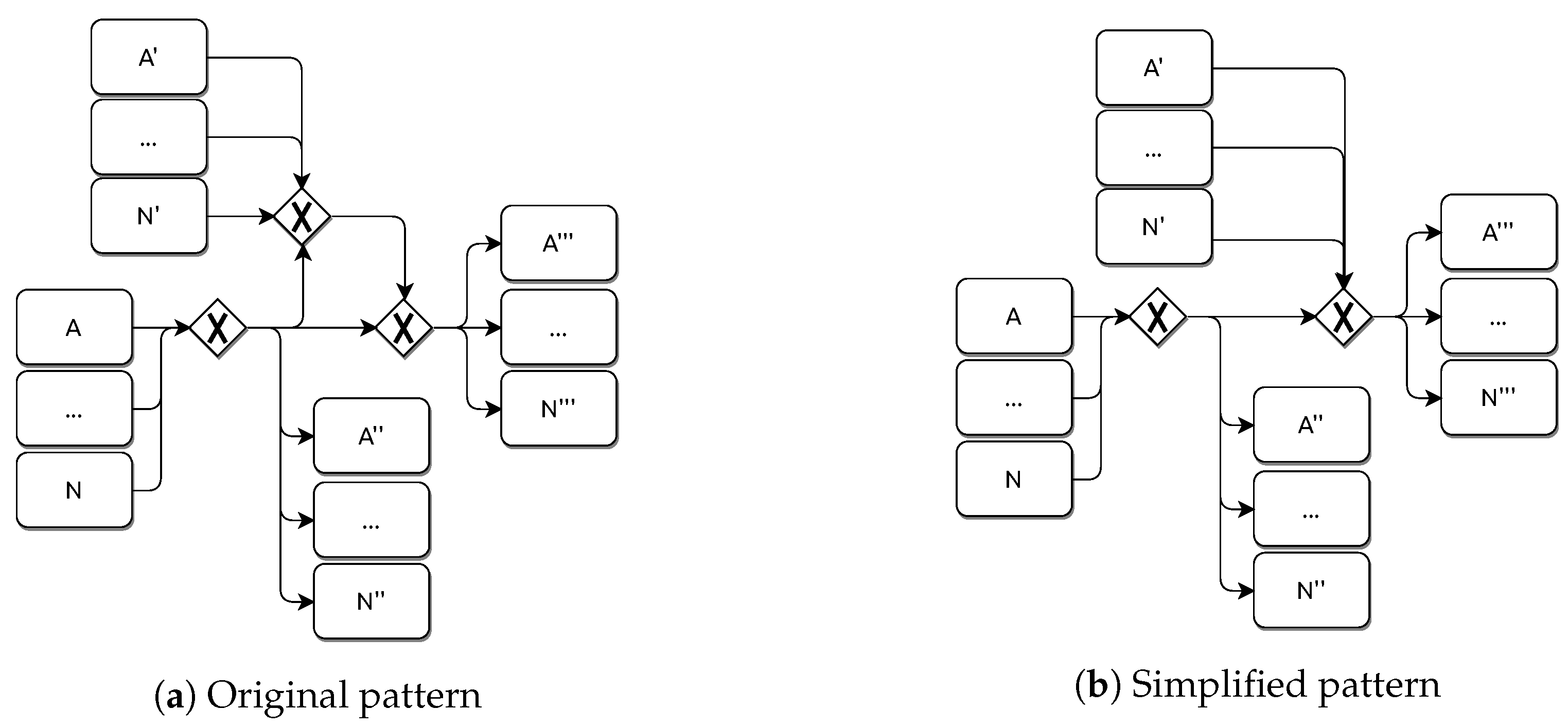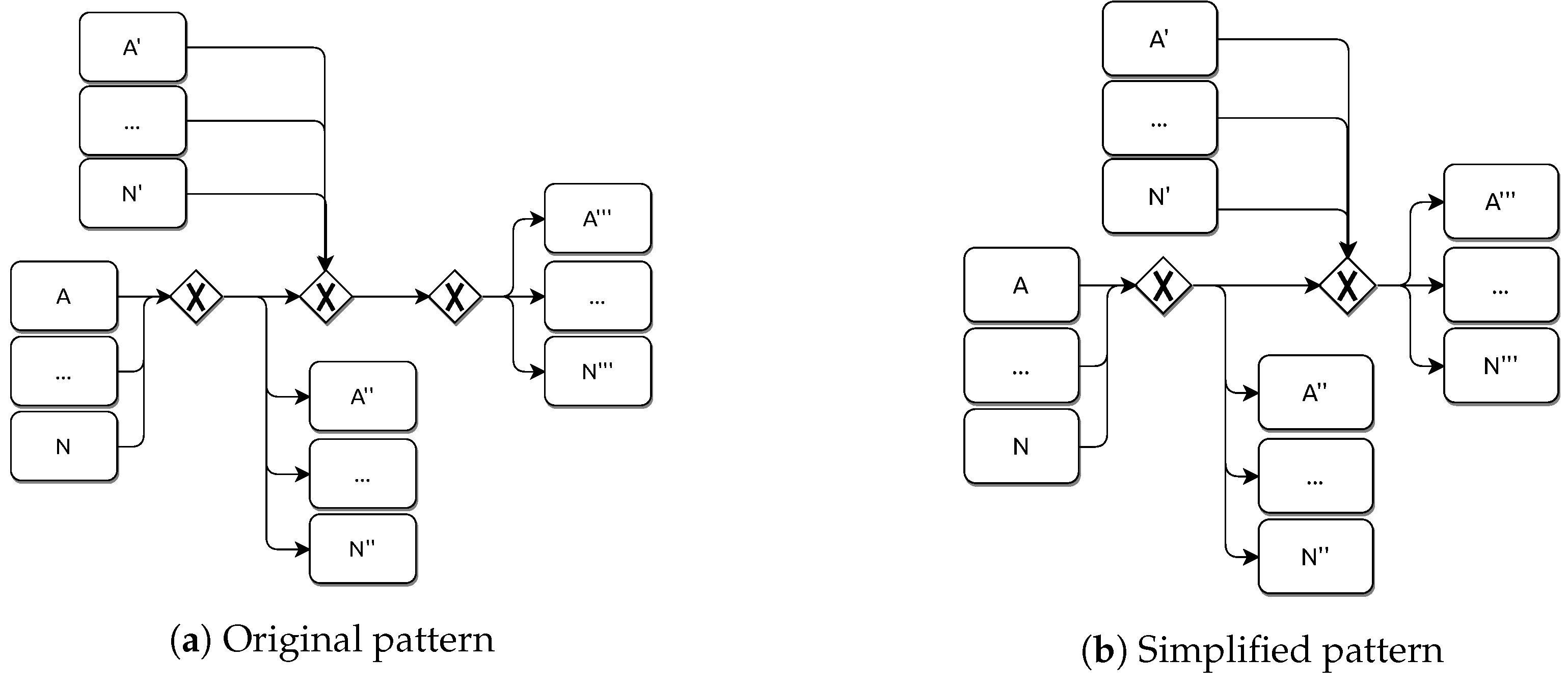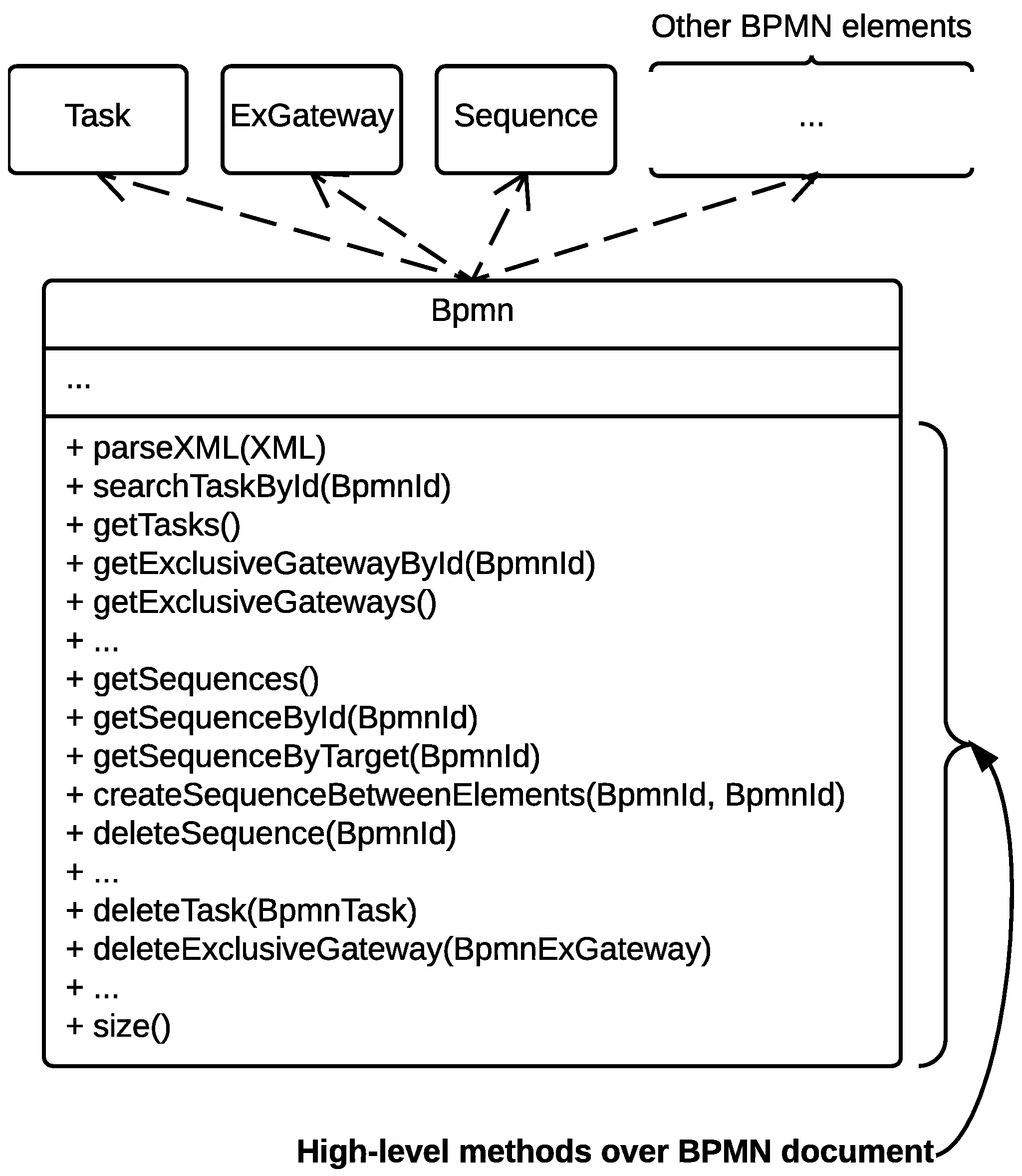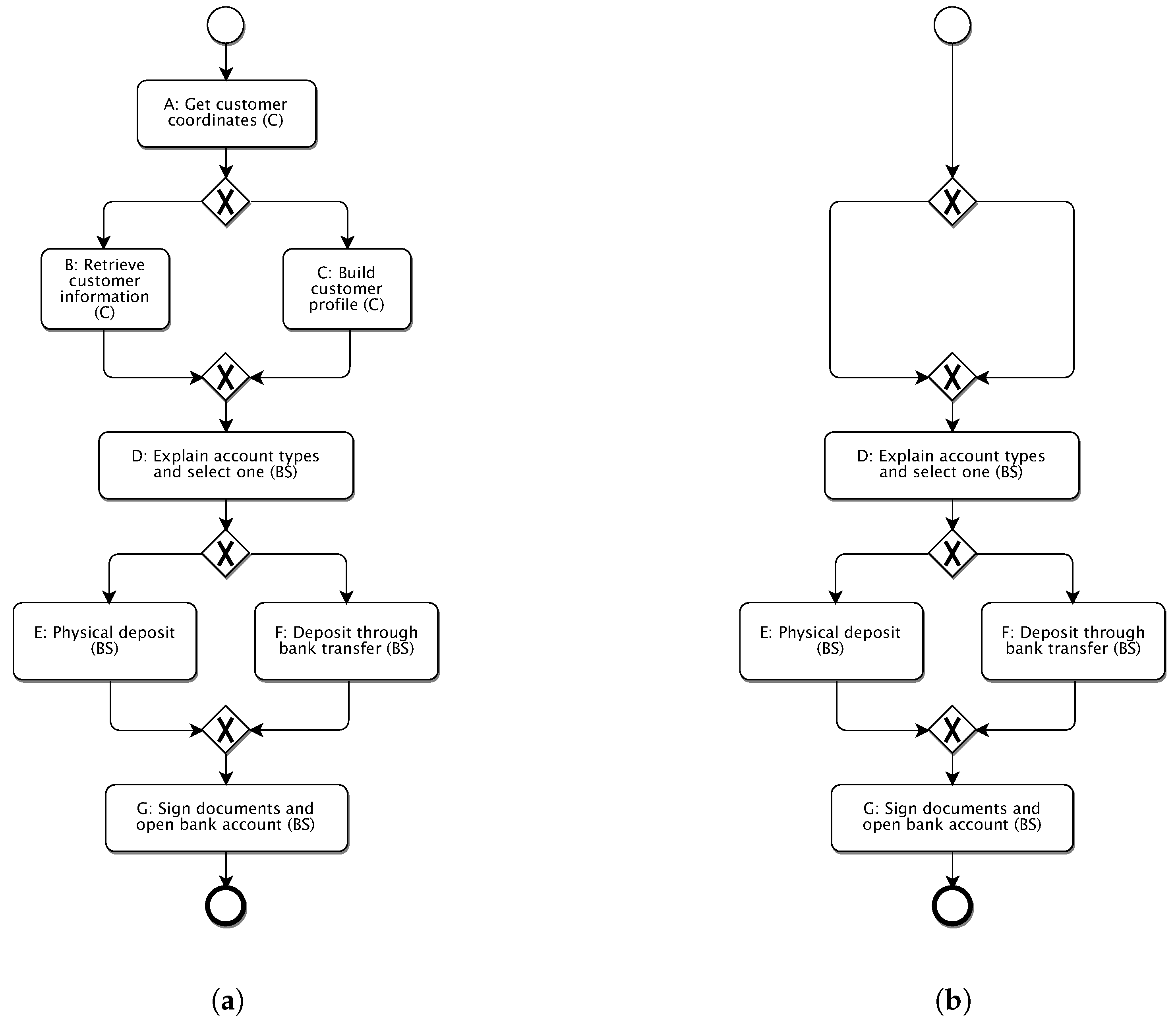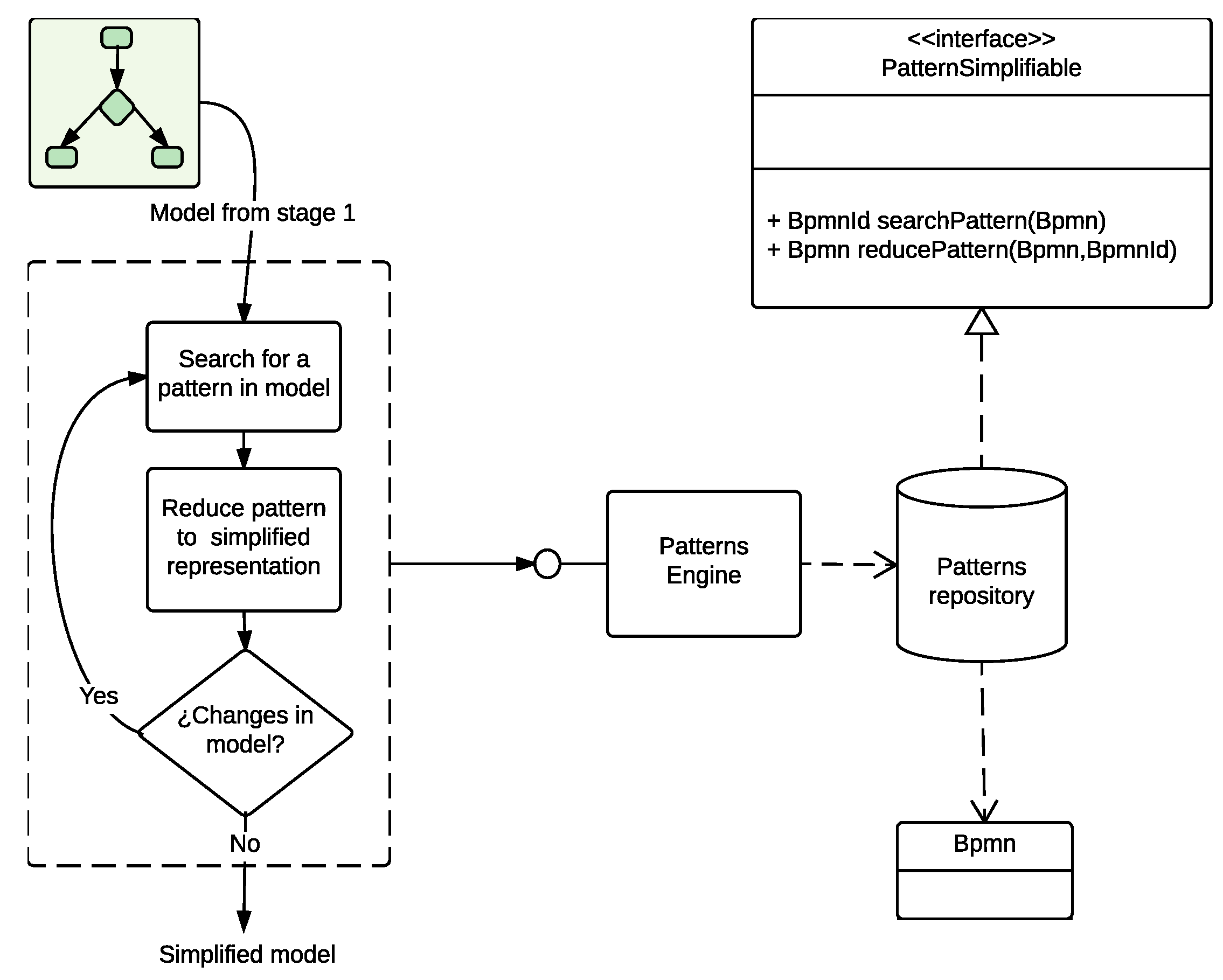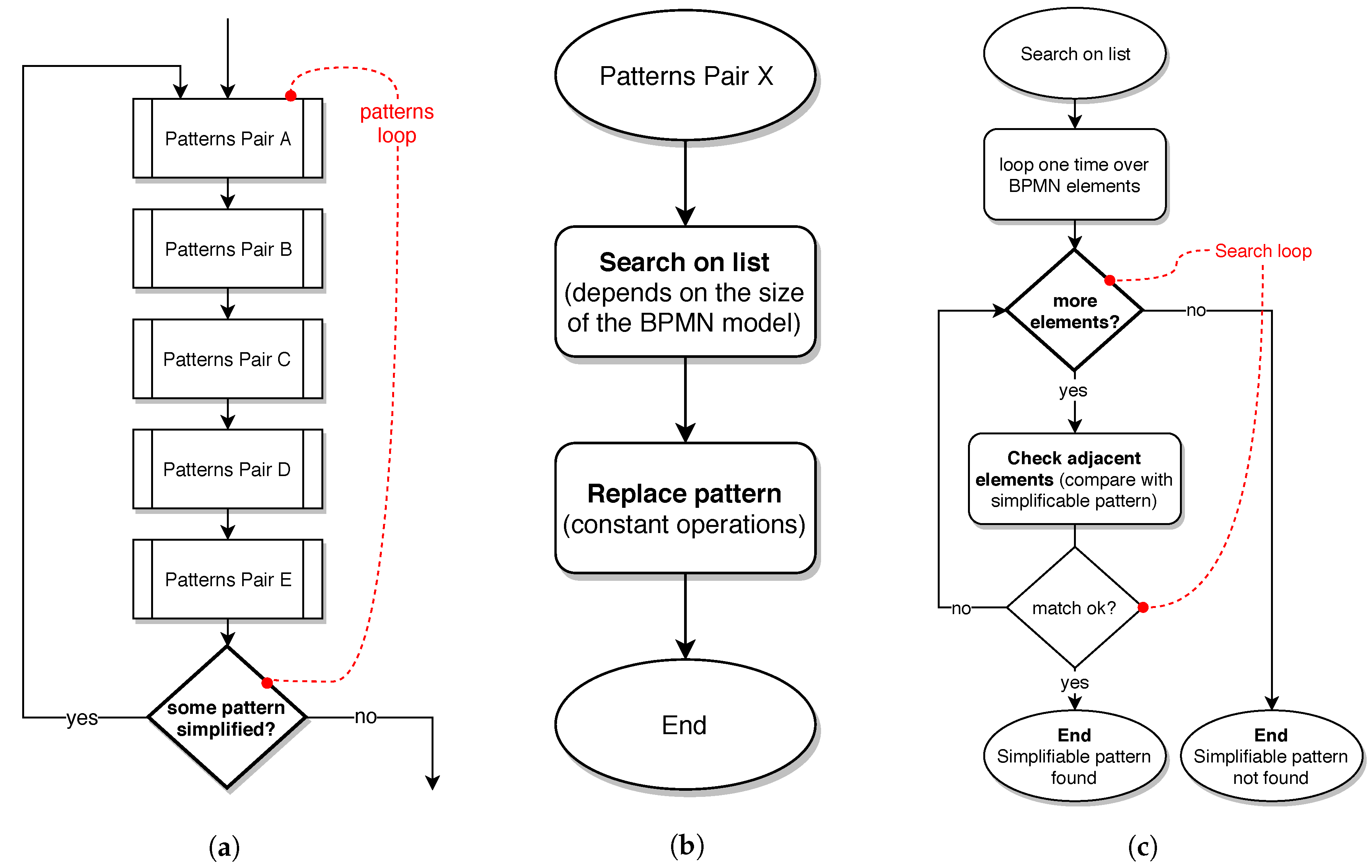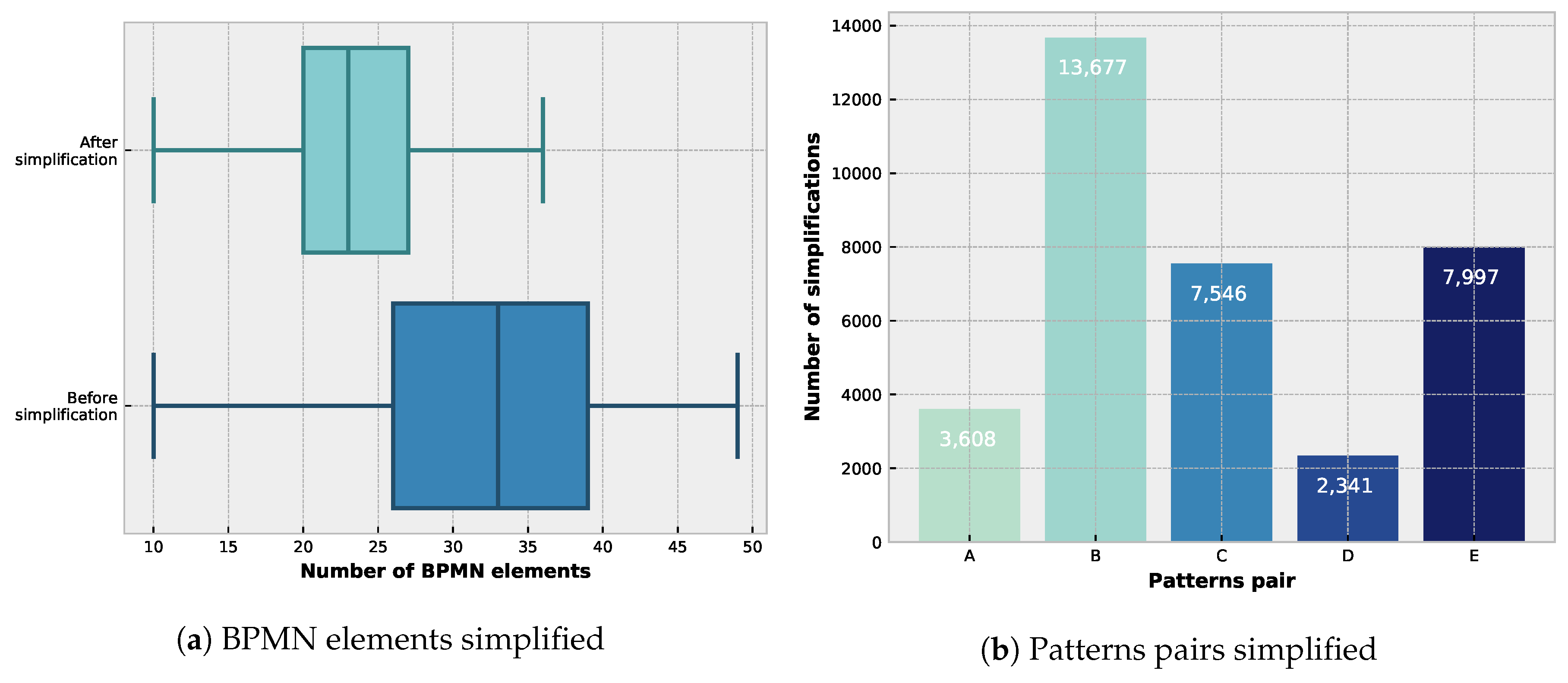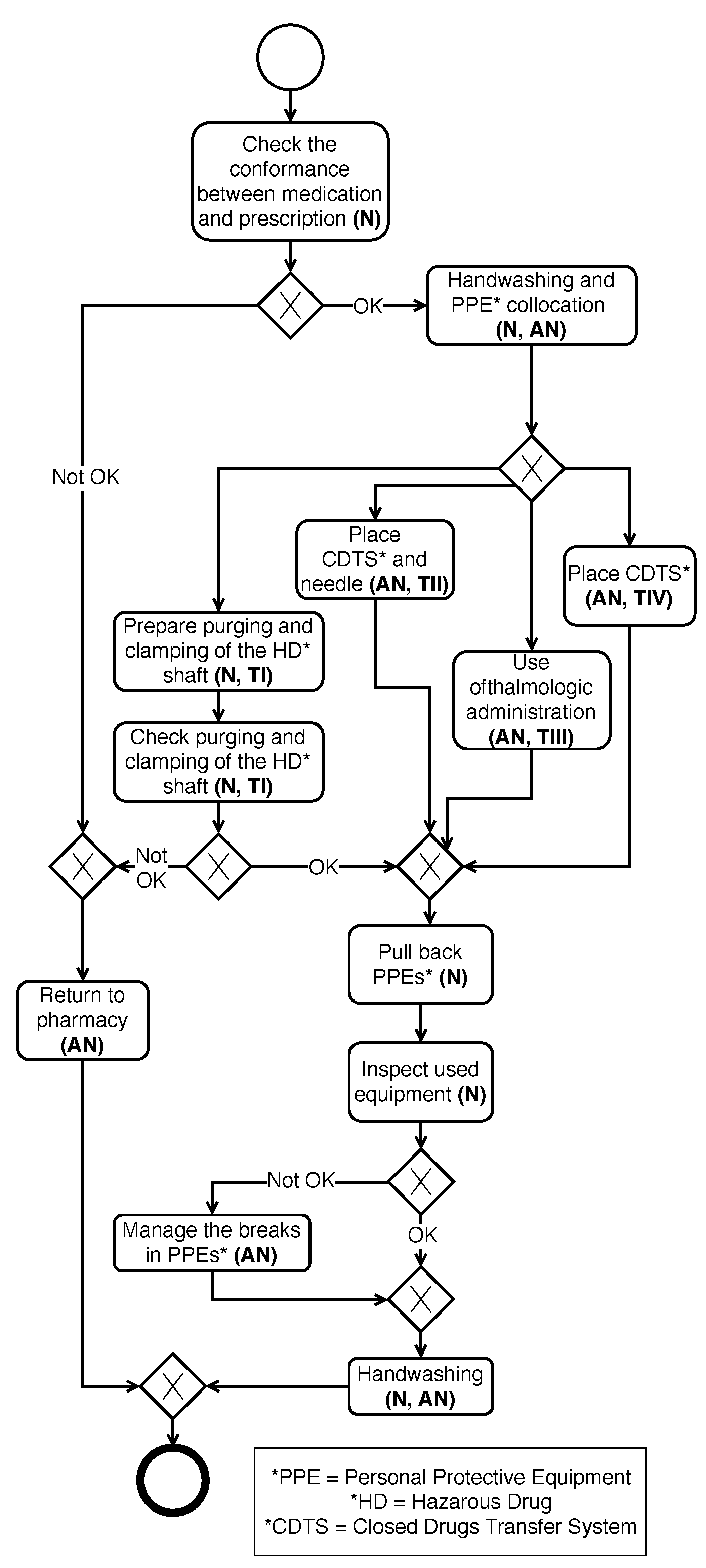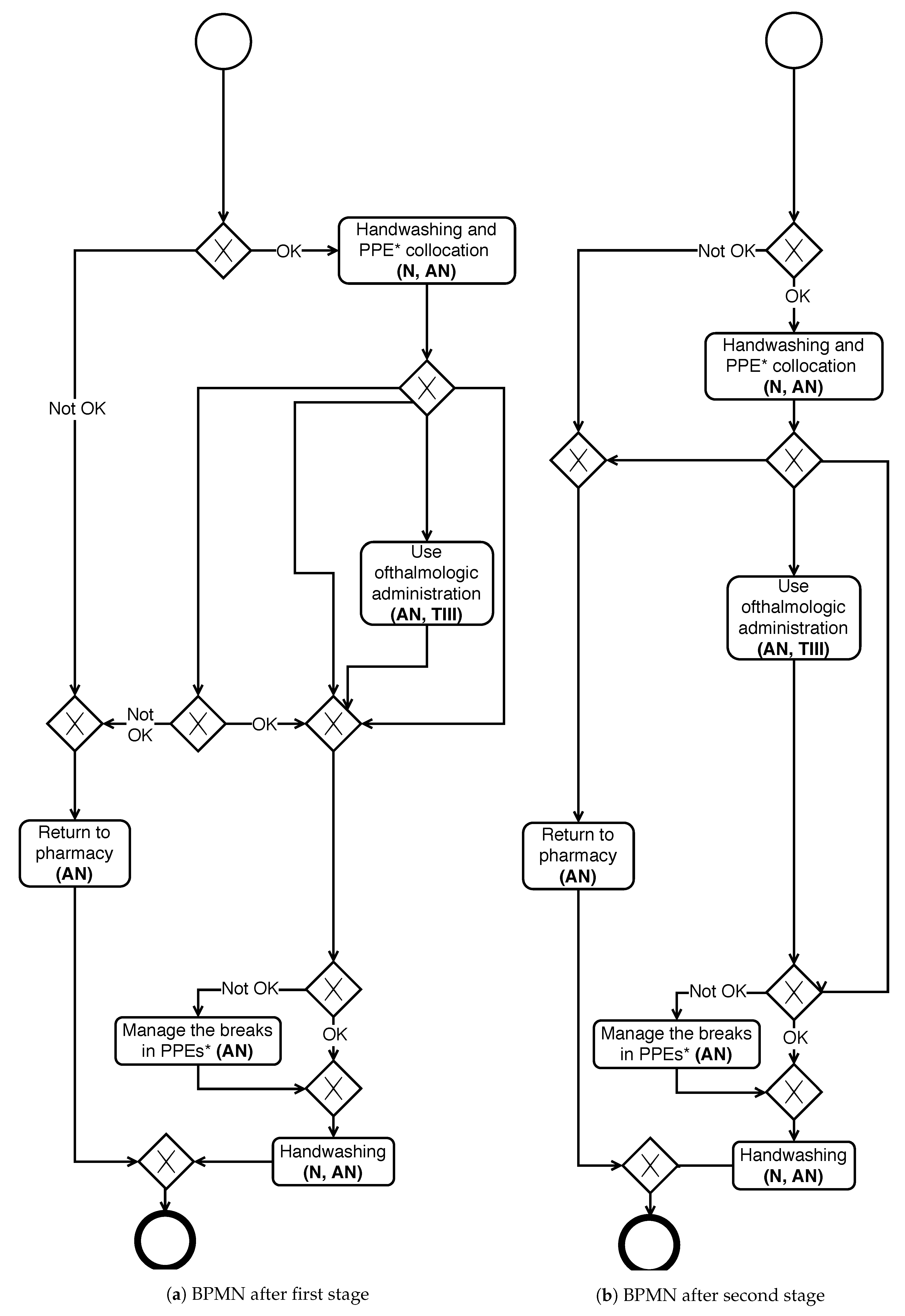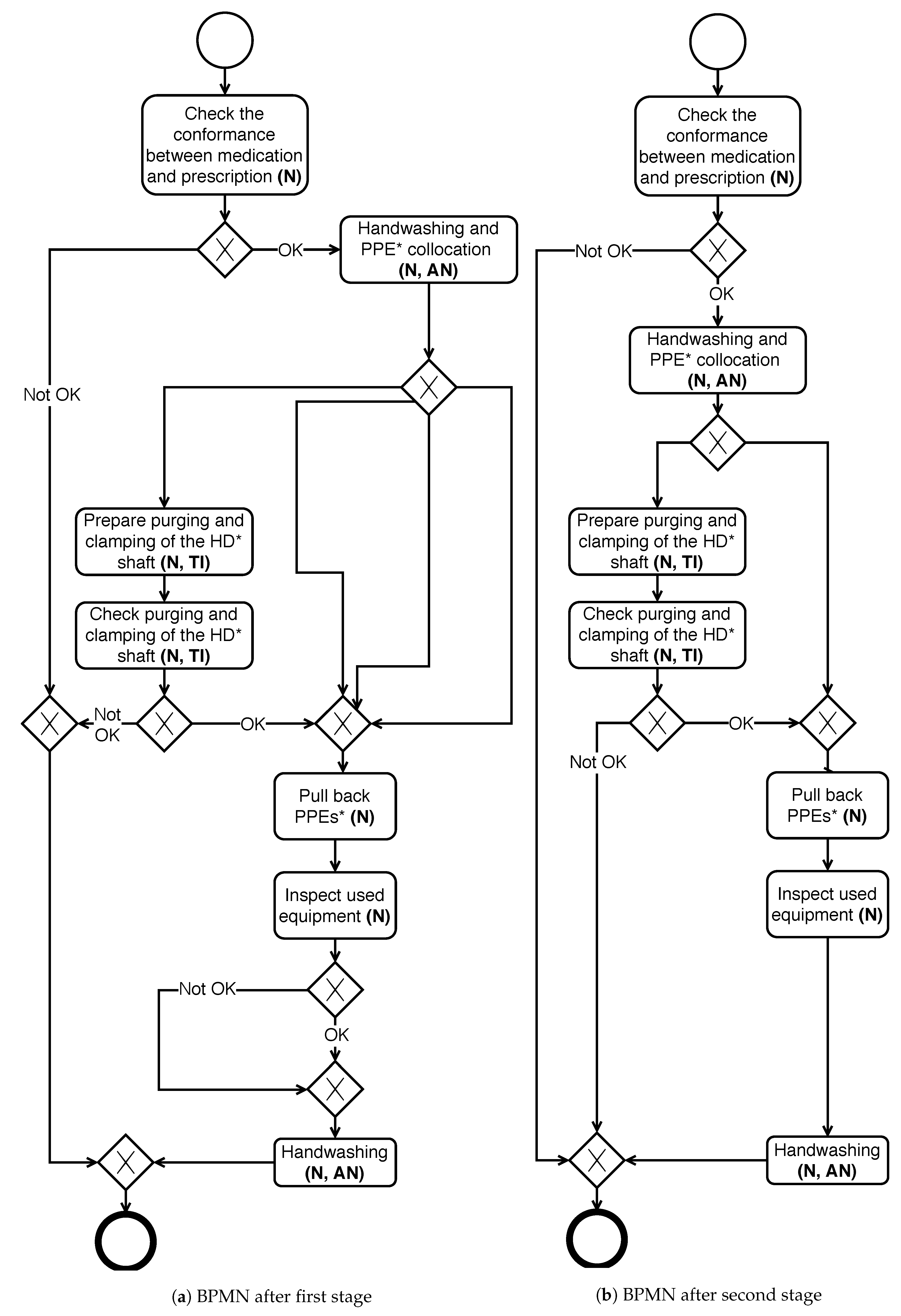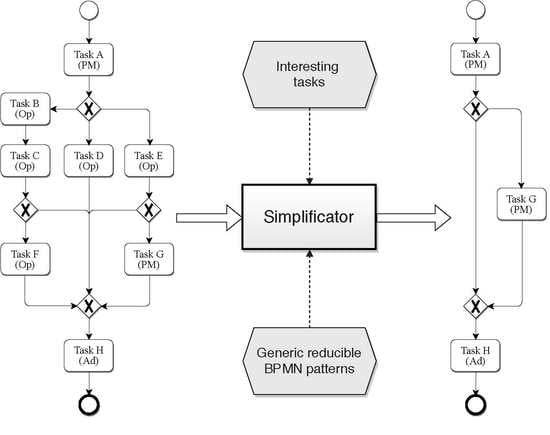1. Introduction
Business Process Model and Notation (BPMN) is an Object Management Group (OMG) standard for specifying business processes. The current version is 2.0.2 [
1], and it allows the modelling of business processes both from a graphical perspective and from a machine-readable perspective (using an XML-based representation). It makes BPMN a suitable language for the description of processes in a visual way and their subsequent analysis using data analytic or process mining techniques [
2]. Presently, BPMN is a leading industry standard for specifying workflows. It is broadly used, for example, in the domain of health-care protocols [
3], software process tailoring [
4], Data Quality management [
5] or Internet of Things proceedings [
6], among many other cases.
This paper describes an approach for the simplification of a BPMN process model aimed to optimise the number of elements included in the workflow. During the simplification task, the behaviour described initially must be preserved, i.e., the new simplified workflow model must be coherent with the original one, offering the same flow logic.
This simplification procedure aims to achieve two primary goals, namely:
It must be borne in mind that an efficient BPMN simplification can be a complicated task. In real scenarios, the number of possible paths in a workflow can grow very fast as the number of activities increases. Furthermore, due to loops and other structures in the model, the number of different combinations in the activities execution can cause an explosion in the number of states. This paper shows an iterative procedure to achieve the simplification objective. In the proposed approach, the deployment of a Pattern Repository will play a principal role in the simplification procedure. This pool of BPMN-based patterns is gathered by the authors, and it contains the core of the proposal.
The main goal of this contribution is to provide a mechanism to simplify, if possible, a given BPMN Process type workflow (that describes a sequence or flow of activities with the objective of carrying out work). This type of workflows are commonly created in a non-automatic manner, i.e., a human operator creates them. First of all, this manual creation process is prone to introduce redundant or repetitive paths that do not provide new information to the behaviour of the model. In this situation, the proposed algorithm will identify the unnecessary elements and will generate a new simplified BPMN diagram offering an equivalent description of the workflow. Secondly, the application of the simplification algorithm is also intended for more complex issues. In particular, presently, it is common the generation of BPMN diagrams involving hundreds of activities from different perspectives and different levels of abstraction [
8]. It provides a series of advantages [
8] but also results in more complex flowcharts and more analysis time demanding models.
To illustrate that issue, the reader can consider
Figure 1. It represents a process involving activities from three different roles: Project Manager (PM), Operator (Op), and Administrative (Ad). Let us suppose now that due to particular constraints, only a subset of these activities are relevant for concrete analysis. In a specific context, it could be interesting to focus on a particular role (or a set of them). Let’s assume that we are concerned just with management operations, i.e., those performed by the Project Manager and Administrative roles. Therefore, it would be required to eliminate those activities in which the other roles (i.e., the Operator) participate. In this case, taking into account the entire model in
Figure 1a is an unnecessary burden as only activities A, G and H are of interest. Therefore, before launching the analysis (either visually by a human or by any automatic techniques), it will be convenient to get a simplified model containing only the desired activities, like the model shown in
Figure 1b.
In this example, not only the unneeded activities have been eliminated. The resulting model includes fewer Exclusive Gateways and fewer paths (sequence flows). In short, a new version of the entire workflow has been generated, but it was preserved its original behaviour (taking into account only those activities of interest). Despite the simplicity of this example, the complexity of this transformation is elevated for a real world BPMN model.
As the reader may note, if an activity or set of them do not provide any actual information, then removing it can be a real advantage. The simplification is clear in a more compact model: the fewer elements involved, the easier it is to understand the model. Of course, the resulting model can be tackled in a more efficient fashion in further analysis and operations. Analysis of the simplified workflow (including only the needed behaviour) can produce even more transparent and concise results due to the elimination of unnecessary elements. In this way, it is possible to have a general model with hundreds of activities and generate different perspectives depending on the particular interests. With this, we will have access to a complete family of processes.
This type of simplification attains greater significance in real world process models. In an organisation with hundreds of models containing hundreds of activities, it is possible to find superfluous or repetitive paths that do not provide new information to the behaviour of the model.
This work presents an automatic heuristic-based approach to perform this type of simplification on any given BPMN model. Starting with a model (like in
Figure 1a) and a list of the interesting activities, the objective is to achieve a simpler model, as presented in
Figure 1b, containing just the relevant information for a specific goal. To get this result, several issues must be borne in mind as discussed in following sections.
The remainder of this paper is structured as follows. Next section highlights other approaches available in the literature related to this work. Then,
Section 3 discusses about the pattern repository, a main piece of the proposed algorithm.
Section 4 deeply describes the algorithm devised.
Section 5 performs a discussion about the complexity of the algorithm. Afterwards,
Section 6 presents the algorithm validation using 8102 cases taken from real world examples.
Section 7 verifies the usability of the proposal in a real scenario. Finally,
Section 8 points out the conclusions.
2. Related Work
The work presented in this paper is related to initiatives and projects in the Business Process Model Abstraction (BPMA) and Business Process Variability Modeling (BPMV) domains. Main similarities and differences regarding some of the most significant proposals in these areas are reviewed.
BPMA has been proposed in last years (see [
8,
9,
10,
11]) as a solution to a common problem appearing in large companies worldwide. Traditionally, companies maintain process model repositories including thousands of different workflows for each of the perspectives and goals to be tackled. As a consequence, the models within their repositories tend to include complex interrelationships, and they may even include overlaps or the same behaviour in different perspectives [
8]. In this scenario, the primary purpose of BPMA is to design detailed models containing the whole set of information about the processes and to provide suitable abstraction mechanisms for generating the desired model view. This way, different kinds of users can access different views and perspectives on processes with an adapted visualisation. The approach proposed in our work can help to achieve these objectives, as it is intended to provide an algorithm to generate a simplification on a process model based on a set of relevant activities.
According to [
8], and based on the cartographic generalisation by [
12], BPMA deals with three main generalisation components: “why”, “when” and “how”. “Why” is concerned with the reasons and the goals of the abstraction. “When” includes the rules, thresholds and conditions to perform the abstraction. “How” describes the transformation and techniques for achieving the abstraction. This last one explains the method and the algorithms for performing the simplifications of the models. The simplification algorithm proposed is framed on the “how” generalisation component of BPMA.
The basic abstraction operations defined in BPMA are “elimination” (to delete elements in the model to reduce the coverage level) and “aggregation” (to create groups of elements to increase the granularity level). The former produces a model containing no information about the deleted elements while the latter preserves some part of the information. In the present work, the simplification algorithm is concerned with the elimination operation using a pattern matching method. In fact, some BPMA approaches, such as [
13,
14,
15], perform eliminations using a sibling concept including Event-Driven Process Chains (EPCs) [
16] fragments and transformation rules. There are also some other works that explore the pattern reduction method, using a closer approach to this proposal. In [
17], five reduction rules that remove the undesired elements in the workflow model are presented. The authors aim to identify structural conflicts in the process model (like deadlocks and lack of synchronisation). They propose some correctness criteria to identify this structural conflicts by exploring all possible instance sub-graphs. However, starting with a brute force method to explore them may not be computationally effective in many contexts. To fight back this issue, they propose to perform firstly a simplification of the model based on these five rules previously identified. In our case, the objective is to delete from the model all the elements and structures that are correct but not significant for purposes of analysis, and, then, to explore the resulting model. However, even the simplification concept can be similar in some way to the previous works, the final goal is very different. The major similarities are related to the “adjacent reduction” and “closed reduction” rules. These rules can be applied in both works: [
17] and the current one.
In any case, these works tackle the issue exclusively from a theoretical point of view, not a practical one. They do not provide a practical mechanism capable of carrying out and implementing these operations automatically. Additionally, these approaches are not based on BPMN notation, but on other languages and models (for example EPC). On the contrary, our proposal focuses, firstly, on providing a practical mechanism that, using a scalable repository of patterns, implements a solution in a fully automatic manner. Secondly, it is based on the BPMN language, the most widely used solution for the description of workflows in productive environments.
In [
15] it is used some of the reduction rules previously identified in [
17], but with a different purpose. In this case, the objective is closer to BPMA. The authors of this work are concerned with the “how” component and focus their efforts on the elimination operation. They identify Single Entry Single Exit (SESE) blocks and substitute them with edges or paths. In this procedure, the authors apply reduction rules for simplifying some elements in the process model. Besides of these similarities, the simplification rules are not the most important part of that contribution. The core contribution of these works is concerned mainly with the aggregation and elimination operations on the so-called SESE blocks. Also, they are not focused on BPMN, as they are using what they call “process schemes”, a process graph with atomic activities and control elements between them. Moreover, our approach is not limited only to Single Entry Single Exit blocks. Multiple Entry Multiple Exit blocks are also analysed.
It is common in organisations to work with families of process variants. In this way, the conventional modelling languages have not specific support to represent these families. Over the past decade, several approaches have studied the Business Process Variability Modeling (BPVM) field in order to tackle this issue by extending the conventional business process modelling languages [
18]. Presents a complete survey in the BPVM domain. It analyses 66 relevant publication from the year 2000 that cover 23 approaches to solving the problem. According to the variability mechanism, the approaches can be sorted into four classes: node configuration, element annotation, activity specialisation and fragment customisation. The approach proposed in the current paper can be categorised in the fourth class: fragment customisation. This class includes the works that propose the manipulation (insert, delete or modify) of entire fragments in order to create variation and customisation of the base process model. This class includes two main groups of approaches: Process variants by options (the most relevant works are [
19,
20,
21,
22]) and Template and Rules (the most relevant works are [
23,
24]). In the first group, the main idea is to mark the process model with the called adjustment points and to perform the change operations over these predefined points. This approach supports four types of operations to change the process flow: delete, insert, modify and move. For example, with the move operation, it is possible to relocate a fragment in the base model bounded by two adjustment points to another part bounded by two distinct adjustment points. The second group associates a set of business rules to a specific template model that will be used to perform the change operations. The different process model perspectives allowed in the family can be inferred by using the rules associated with the template model.
Meanwhile the main concepts behind all the BPVM approaches are very similar to our work, the philosophy and the application of the proposal are quite different. In particular, our approach uses a combination of the insert and delete basic manipulations to implement a complex operation: replace. In our case, a full Multiple Entry Multiple Exit fragment will be replaced by a simplified version offering the same behaviour but using fewer elements. One of the keys of our proposal lies in to obtain an efficient process model (i.e., with fewer elements). Moreover, our approach is generic and can be applied without modification to any BPMN process model. The most relevant works in the literature discussed in this section do not use this approach. They define rules and fragment for a specific family of models used by a specific organisation.
Other related works are those that deal with Business Process (BP) patterns [
25]. The BP patterns are examples of process modelling that show how to connect activities within the workflow to solve a specific problem (i.e., synchronisation, parallel split, or exclusive choice, among others). To represent these patterns, a fully graphical notation oriented to human users is usually used. The Workflow Patterns Initiative has been working since 1999 in this field. The objective of this initiative is to provide a conceptual basis for business process design on different modelling perspectives (control flow, data, resource, and exception handling). Using the proposed patterns, the modelling stage of the business process is facilitated and a concise and straightforward workflow that adequately represents the desired behaviour is achieved. This goal has certain similarities with the one pursued by the present article. The BP patterns intend to approach the problem from the beginning, the modelling phase, while our proposal has another approach. A given model can change along its life cycle, so simplification in later phases, after the initial modelling stage, can be required. The following sections show actual situations (common in certain fields [
26]) where it is required to remove a subset of the activities from a BPMN model. Under this premise, the simplification of the BPMN in the middle of its life cycle turns out to be of the utmost importance. In this context, the present proposal stands out, developing an alternative point of view and automating the task of simplification.
The gist of the above-mentioned works on BPMA and BP patterns has much in common with the fields of refactoring [
27] and anti-patterns [
28] which in turn are closely related to our proposal. Antipatterns share certain features with the simplifiable fragments of a process model and can be found for different modelling languages (EPC, BPMN, PetriNets, YAWL, among others). The task of refactoring resembles the action of searching and replacing these fragments with an optimised version. For a long time, there have been many works devoted to refactoring on varied contexts (for example centred on Unified Modeling Language (UML) diagrams [
29], class diagrams [
30] or use cases [
31]) but it has been just in recent years when more proposals related to process models have appeared. In general, each work has different objectives and different refactoring premises (quality in terms of the number of elements, ease of understanding, consistency with changes, etc.). Ref. [
32] focus on those process models that are shared by different users and analyse how to maintain a dynamic workflow in which several people interact along their life cycle. These works focus on evaluating the consistency of the patterns in this type of dynamic environments. There is a large number of works, for example [
33,
34], that aim to improve some aspect of the quality of the models through refactoring but do not present a fully automated mechanism. In these works, assistance to the user is particularly relevant as they suggest sets of model refactorings. Ref. [
35] presents an interesting approach in which human interaction plays an important role in replacing fragments taking into account the semantics of the model and the real behaviour intended to be represented. Therefore, it is possible to propose substitutions that, even though not formally coherent, result in a final model more friendly and very simplified. However, in order to achieve this objective, the automation of the process is also sacrificed.
A set of works in the bibliography related to refactoring follow an approach that is known as Model transformations by demonstration (for example [
36,
37]). The general idea is first to monitor the substitution procedure performed by a human user. Thus, all atomic operations performed by the user are captured by comparing the initial and final models. In this way, they can propose a set of recommendations associated with the refactoring operations that are used to assist the simplification procedure. During the last few years, many works related to the application of refactoring and antipatterns techniques for the field of process models have emerged. However, and to the best of our knowledge, neither of them focuses on the type of patterns identified in this work nor shares the goal tackled by this work. This is due, in part, to the fact that the patterns considered by our work are not very common in the early stages of the life cycle of process models. This situation changes when analysing successive iterations in process remodelling. Notably, the patterns proposed here begin to appear, and their substitution becomes especially important when the process model has to undergo changes. In this scenario, it may be very useful to eliminate subsets of activities. These circumstances occur more often than is usually thought at first sight since the remodelling and enhancement of a process model is an essential task within the life cycle of BPMN models.
Another point that is not very usual in the field of refactoring and that occurs in the present work is based on using additional information about the process model itself to carry out the simplification. This aspect can be seen in the examples proposed in
Section 7, which takes into account the roles of the people involved in the process to perform various types of simplifications. This approach is mentioned as a trend and research opportunity in [
38]. This document also considers as a relevant trend the creation of fully automatic mechanisms for simplification. This feature is also a relevant aspect in the present work.
From a high level of abstraction, and contrary to other approaches already mentioned in the literature review, the main objective in the current work is to achieve a simpler and more efficient model to use in combination with additional analysis and process mining techniques to improve the understanding of the model by a human user (similar goals are discussed as future challenges for the Business Process Model domain in [
39]). Furthermore, this work is performed over the preferred standard for the representation and analysis of business processes, BPMN, making it of a broader usage for the community.
4. Algorithm Description
The model simplification algorithm is tackled in a two-stage approach. The first stage is concerned with the generation of the new version of the model by removing the undesired/unneeded tasks. Afterwards, using this new model as input, the optimised version of the model is obtained as the result of an iterative procedure that uses the repository of patterns described previously. Eventually, a redesigned and simpler version of the model, if possible, is obtained.
In the following subsections a real world example will be presented to illustrate the phases of the algorithm. An excerpt of a workflow that describes the process of opening a bank account is considered. In this workflow (cf.
Figure 8), activities can be classified into two groups:
4.1. First Stage: Deleting Undesired Activities
On the first stage of the proposed schema, undesired activities selected by the user must be removed. The resulting model must be still coherent. Therefore, the algorithm must delete the appropriate sequence flows in the BPMN models too (i.e., sequence flows connecting the deleted activity). Also, new sequences connecting the surrounding elements of a deleted activity (previous with next ones) must be created. In
Figure 8 an example is shown of the input and the output of this stage, in case of aiming at getting a simplified version of the workflow for operations requiring interaction only with the bank staff,
Figure 8a (representing the input) is considered as the starting point. In this line,
Figure 8b represents the output model where sequence flows replace the operations without interaction with bank staff.
As the reader can note, in this new model, not all elements in
Figure 8b are required to represent the desired behaviour. This issue will be tackled later on, on the second stage of the algorithm.
A fragment of the Java implementation for the first stage is presented in the Listing 3. The first stage function loops over the list of activities to be deleted and removes the activities defined by the user. To delete one single activity it is mandatory to establish a direct connection between the previous element and the upcoming one (another activity, a gateway, etc.). Upon the new connection is created, it is possible to delete the old activity and the old sequences as they are no longer of any use in the model.
1 public Bpmn firstStage ( Bpmn model , ArrayList < BpmnId > tasksToDeleteIds ){
2 for (Id taskToDeleteId : tasksToDeleteIds )
3 {// Search each task to delete ...
4 BpmnTask task2Del = model . searchTaskById ( taskToDeleteId );
5
6 // ... and delete it safetely
7 model = this . deleteTask (model , task2Del );
8 }
9 return model ;
10 }
11
12 // Deletes a task in a safetely way
13 private Bpmn deleteTask ( Bpmn model , BpmnTask task2Del ){
14
15 // Search sequences Ids
16 BpmnId inSeq = task2Del . getInSequenceId ();
17 BpmnId outSeq = task2Del . getOutSequenceId ();
18
19 // Search elements before / after these sequences
20 BpmnId elmntBeforeTaskId = model . getSequenceById ( inSeq ). getSource ();
21 BpmnId elmntAfterTaskId = model . getSequenceById ( outSeq ). getTarget ();
22
23 // New connection skipping the activity
24 model . createSequenceBetweenElements ( elmntBeforeTaskId , elmntAfterTaskId );
25
26 // Delete activity and old sequences
27 model . deleteTask ( task2Del );
28 model . deleteSequence ( inSequenceId );
29 model . deleteSequence ( outSequenceId );
30
31 return model ;
32 }
Listing 3: First Stage Java code.
In this first stage, a simple method to remove the undesired activities is used: to delete one, a direct connection between the previous element and the upcoming one (another activity, a gateway, etc.) is established. Upon the new connection is created, it is possible to delete the old activity and the old sequences as they are no longer of any use in the model.
4.2. Second Stage: Simplifying the Model
In this stage, the goal is to simplify the outcome from the previous stage to obtain a simpler version. As the reader can note from
Figure 8b, the workflow produced in the first stage can include unneeded BPMN elements and, therefore, it can be simplified to conduct more efficiently further operations on it. This is because the first stage eliminates the activities creating connections between previous and upcoming elements.
Figure 9 shows the general architecture for the second stage. As the reader can see, different elements must work together to conduct the simplification of the model. The pattern repository uses a
class containing general utility functions to perform operations over the BPMN model. The Patterns Engine, in the centre of the figure, can use the patterns included in the repository to offer a high level API that is used to perform the simplification.
An excerpt of the Java implementation for this engine and the API deployed is shown in the Listing 4. The piece of code includes some essential methods that will be used for the second stage algorithm. The engine maintains a list of the patterns available in the repository (check line 3). This list is dynamically populated in the constructor method of the engine. It allows looping over all the patterns simplifying each one in the model. The engine also offers methods to simplify of the next pattern in the list (lines 20–31), to check if the list has been entirely explored (lines 33–38), and to rewind the pattern iterator (lines 40–42).
1 public class PatternsEngine
2 {
3 ArrayList < SimplifiablePattern > patterns ;
4 int current ;
5
6 // Engine constructor
7 PatternsEngine (){
8 // Load dinamically all patterns in repository
9 // Exception handling omited
10 Reflections r = new Reflections (" repository . package ");
11 Set <Class <? extends SimplifiablePattern >> repo =
12 r. getSubTypesOf ( SimplifiablePattern . class );
13
14 patterns = new ArrayList < >();
15 for (Class <? extends SimplifiablePattern > pat : repo ) {
16 patterns .add (pat . newInstance ());
17 }
18 }
19
20 // Simplify next pattern in the BPMN model
21 public Bpmn simplifyNext ( Bpmn model ){
22 SimplifiablePattern aPattern = patterns . get ( current );
23 if( this . hasNext ()){
24 currentPattern ++;
25 }
26 BpmnId startElmnt = aPattern . searchPattern ( model );
27 if ( startElmnt != null ){
28 model = aPattern . reducePattern (model , startElmnt );
29 }
30 return model ;
31 }
32
33 public boolean hasNext (){
34 if(currentPattern < patterns . size ())
35 return true ;
36 else
37 return false ;
38 }
39
40 public void rewindPatterns (){
41 currentPattern = 0;
42 }
43 }
Listing 4: Patterns Engine Java code.
In this stage, the algorithm, using the API offered by the , looks for existing sub-models in the input model that matches any of the existing ones in the repository. Upon each matching, the corresponding transformation is conducted. This process keeps on going until no more changes on the model are possible. The process of searching and reducing a pattern is performed until no more reductions can be evaluated over the model.
Finally, as an example, in
Figure 10 the reader can see the outcome of the second stage on the model from
Figure 8.
5. Complexity
In this section, the complexity of the algorithm is analysed from two different points of view: (i) regarding the size of the input BPMN model and (ii) regarding the number of pattern pairs in the repository.
To carry out this analysis, the flow diagrams shown in
Figure 11 will be used. These diagrams contain the basic behaviour of the algorithm with the most relevant operations from the point of view of time complexity. Firstly (see
Figure 11a), the algorithm consists of a patterns loop that runs through the set of pairs of patterns within the repository. As explained in the
Section 4, this loop is executed until no more patterns to simplify can be found. In this way, the number of executions of the loop depends on the complexity of BPMN model under consideration.
In each execution of the patterns loop, each of the pairs of patterns is probed (with the search operation) for a possible replacement (see
Figure 11a).
The replacement of a pattern (
Figure 11b) has a complexity of
because its execution time does not depend on the size of the BPMN model or the number of patterns in the repository. The replacement operation involves simple modifications on the BPMN model, actually, just adjusting or deleting some BPMN elements. The reader can see on the Listing 2 the Java code responsible for the replacement of pattern A (lines 21–36).
Regarding the search operation (
Figure 11b,c), its complexity cannot be disregarded. The search for a possible simplifiable pattern needs to carry out a loop that checks each element included in the BPMN model. However, it is sufficient to go through the entire list of elements only once during a search operation. In each iteration the focus is on one BPMN element and its immediately adjacent elements (those connected directly with a sequence flow stereotype). The idea is to check if the relationship between the considered element and its adjacent elements is identical to the one expressed in the simplifiable pattern. These check operations have a complexity of
(typically it will be a comparison between pairs of values) and their execution time does not depend on the size of the BPMN, nor the number of patterns in the repository. As the reader can note, the time consumption in this model is due to the search loop (
Figure 11c), which only depends on the size of the BPMN model linearly.
It is also worth noting that it is not uncommon for a BPMN model to show a tree-like design, i.e., to include many branches on its representation. On first thought, this could pose an issue for searching a particular fragment. However, to perform the search for the simplifiable pattern, and due to the model representation that the BPMN notation allows, it is not necessary to dive for the various bifurcations that a model can present. In fact, it is just required to check elements one by one, regardless of its position on the model, to evaluate the adjacent elements in order to verify if a simplifiable pattern can be spotted.
Summing up, it can be stated that the search operation has a complexity . The reader can check an example of a search operation on the Listing 2, which shows the Java code responsible for the search of pattern A (lines 3–18). The creation of the search loop (considering each element of Exclusive Gateway type) is shown on line 5. The number of iterations of this loop depends directly on the size of the BPMN model.
5.1. Complexity Regarding the Size of the BPMN Model
As the reader may anticipate, it is quite common to encounter with large, in terms of elements, BPMN models. Therefore, it is convenient to get an idea beforehand of the scalability of the proposal in terms of number of BPMN elements. This is the reason to estimate the complexity of the given algorithm from the point of view of elements within the BPMN model under consideration.
For the patterns loop (
Figure 11a, the key is to interpret how the number of iterations varies. This value is very dependent on the BPMN model under study but it is not easy to estimate beforehand the number of possible simplification within the model, i.e., the number iterations. The worst case would be to assume that for a given BPMN a simplification should be made for each element of the model. Thus, the relationship between the number of simplifications and the size of the BPMN is direct and linear. As a consequence, it can be set that the complexity can no longer be worse than
. For example, the reader can imagine a BPMN model of size x containing 10 simplifiable patterns, 2 of each of the types contained in the repository. This means that the patterns loop is executed 5 times. If we now imagine a BPMN model of size 10x, it is reasonable to think that it could potentially present 10 times more simplifiable patterns. In this way, the patterns loop would be executed this time 50 times. In this way, we will consider the execution of the patterns loop with a complexity of
with respect to the increase in size of the BPMN model.
In the process of searching and, if the case, replacement of the pairs of patterns, the key lies in the search operations. As mentioned, the replacement of a pattern has a complexity . However, the time spent searching for a pattern depends directly and linearly on the size of the BPMN model. Therefore, this operation has a complexity . Since the repository contains 5 pairs of patterns, the search operation is performed in sequence 5 times. Therefore, according to the rule of the concatenation of actions, the time complexity of the set of searches will be the maximum order of the actions present in the set, that is, .
For the complete algorithm, taking into account the complexity of the loop and the complexity of the search and applying the iteration rule, it follows that the total complexity of the algorithm is . Therefore, the execution time grows quadratically with the size of the BPMN model.
5.2. Complexity Regarding the Size of the Repository
Another factor that could affect the complexity of the algorithm is the number of simplifiable patterns in the repository. As it could impact on the feasibility of the model, it was decided to study the complexity of the algorithm considering this variable.
When the number of patterns in the repository increases, the calls to the search and replacement methods will increase for the same patterns loop execution. However, the time taken to execute the individual search method of each of the patterns does not change (since this only depends on the size of the BPMN model). Moreover, increasing the number of patterns does not have to increase the number of iterations of the patterns loop, as it is just linked to the size of the BPMN model itself. Therefore, the actual increase of the execution time by increasing the number of patterns is directly linked with the new pairs of patterns, adding a search operation of for each pair added. The number of iterations of the loop is not linked with the numbers of pairs of patterns in the repository. For example, the reader can imagine an example in which the patterns loop is executed 5 times. If initially, the repository has 5 patterns, this leads in an execution of 25 search operations. Assuming now that the repository has for example 50 patterns, and that the patterns loop is still running 5 times, this results in 250 search operations. In this way, it follows that the complexity of the algorithm concerning the number of patterns is . Time grows linearly with the number of patterns in the repository.
7. A Proof of Concept on a Real Scenario
An additional evaluation has been carried out to verify the usability of the proposal in a real scenario. The authors have been working during recent years in several projects dedicated to issues related to traceability in a broad sense. In the due course of this researching activities, the authors have tackled the problems derived from hazardous medicines in the health field [
48]. This leads us to propose extensions to the BPMN notation for its application in Hazard Analysis and Critical Control Points (HACCP) [
26] scenarios or to the identification of gaps and needs for standardization of hospital protocols of a dangerous nature [
49], among others. Given this trajectory, the proof of concept for this proposal was focused on the field of the management of hazardous drugs (HDs). HD are those drugs whose handling poses a danger to people (carcinogenicity, teratogenicity, reproductive toxicity, low dose organ toxicity, genotoxicity, among others) [
50]. In [
49], the authors focus their efforts on the identification of the stages that make up the life cycle of the HDs and, for each of them, certain action protocols are defined. Subsequently, in [
51], an assessment is made of the advantages of applying the BPMN extension proposed in [
26] for this domain of interest. In this work, 47 experts in the domain evaluated the benefits of the proposal. An adaptation of a BPMN model presented in this last work was selected to check the usability of the simplification proposal. The chosen BPMN model can be seen in
Figure 13.
This model summarizes the tasks carried out for the administration of an HD. During this stage, two roles are involved: Nurse (N) and Auxiliary Nurse (AN). There are also four possible ways to administer the HD and they are shown in
Table 4.
By collecting the opinions of sanitary experts at different levels about the processes related to the management of dangerous medicines, some existing limitations arose. The models currently in use tend to include all the actions carried out by different health profiles. In this way, it is possible, in a single diagram, to represent several perspectives. However, this introduces a drawback: each of the individual roles involved in the process may have too much information (some of the data can be considered as noise). In this way, the interpretation of the model is sometimes more complicated than necessary and could lead to errors. For example, a person with the AN role may not be interested in knowing the sequence of tasks that another person with the N role must perform. Therefore, it is preferable for the person with the AN role to have a model simplified that represents only those tasks required for his/her role. Following, two particular scenarios that show this idea are presented.
As a first example, let’s assume that a person with the AN role wishes to visualise only the activities involving his/her participation. Besides, he/she is only interested in those tasks involving ophthalmic administration, as this person only is capable of performing this procedure. In this line, the goal of simplification would be to produce a new simpler model that contains only the relevant information for this context. Applying the proposed two-phase algorithm, it would be possible to obtain the BPMN models shown in
Figure 14a,b (output of stages 1 and 2, respectively). The model in
Figure 14b represents in a much more synthetic way the relevant information for the AN role.
For the second example, let’s consider the case of a person also involved in the administration of the HD under the role N that wants to check the tasks that must perform. In this case, the list of activities removed in the first stage is different from the first example. The new resulting models generated for this new context are shown in
Figure 15a,b.
As shown, in both cases, the simplification procedure strives to offer a simpler model. This new model allows analysing the desired information with a representation that contains fewer elements resulting in a clearer model for the user with a particular rol. The difference between the models represented in
Figure 14a,b (the same for
Figure 15a,b) is evident. Even both represent the same behaviour but, in the cases of
Figure 14b and
Figure 15b, the model is simpler and faster to interpret by the human user.
In addition to facilitating the visual reading, the subsequent application of business process techniques is improved (e.g., analysis of most used routes, failure analysis or conformance checking analysis, among others). Many times, the application of these techniques produces results with a difficult interpretation since it is necessary to be familiar with this type of techniques to make the most of the results obtained. In this line, the cleaner the BPMN model, the easier the interpretation and the less error will arise by humans.
8. Conclusions
Presently, the usage of BPMN models for the characterisation and the analysis of processes is common in the academic and industrial environment. From its usage, many advantages arise such as better analysis of costs, more in-depth tracking of raw material and final products, more complete documentation for auditing processes, etc. On this daily usage, we may face the need to perform transformations (aggregation or removal) on steps, processes, or tasks.
To be able to apply in an optimum manner the already existing techniques in the domain of Data Analytics and Process Mining to conduct analysis and studies, it is desirable to work on a minimum but equivalent BPMN model. It is at this point where this proposal comes into the scene. It is possible to perform transformations to achieve a simplified model by taking advantage of the proposed scheme. Even if it is not possible to guarantee the attainment of the optimal solution; we can get, in an entirely automatic fashion, an optimised version of the original model ensuring non-wrong solutions.
This proposal was successfully used in support of actual projects such as [
48]. In due course of the mentioned project, it turned out to be necessary to be able to generate a simplified model with a subset of the activities. In this project, protocols are defined following the Hazard Analysis and Critical Control Points (HACCP) [
52] system. In HACCP environments it is common to use a subset of the BPMN language (this has been taken into account in the approach of the proposal). These protocols are documented graphically using an extension of BPMN, BPMNE2 [
26] that is oriented to identify certain critical aspects related to the security of the process instances. The monitoring of them is carried out using the ToCP platform [
53,
54]. To carry out the audit, Process Mining techniques are used, mainly conformance checking, on the event logs generated in the monitoring points. Before carrying out these analyses, it is convenient to eliminate activities that do not generate event logs from the BMPNE2 models, obtaining a simplified graph. Therefore, it is possible to use tools such as ProM [
55] immediately and to reduce the analysis times while improving the graphic understanding for humans.
As already discussed in the review of related works, there exist some similarities between the work presented in this paper and other approaches. Nevertheless, to the best knowledge of the authors, no previous works describe an approach oriented to these contexts with enough detail level to guide further attempts on the field.
With the heuristic algorithm designed, it is achieved a generic, open and flexible approach to perform the simplification of BPMN models. A relevant feature is the generation of a repository for patterns. This element, a key element of the implementation, was designed in an extensible way. Therefore, it is easy to populate the repository with new patterns identified for improving the simplification process.
Despite the utility of the proposal, certain aspects could be improved in the future. A pending issue for future enhancement is linked to the fact that patterns in the repository have to be defined manually by experts in the domain. This same fact causes that it cannot be assured formally that all the possible patterns have been found in such a way that achieves the simplest possible final diagram. Having to implement manually (currently using Java) the patterns themselves and their simplified versions is a difficulty for its broad adoption. As a future line, the creation of an automated mechanism that performs this task could be tackled. Nevertheless, it seems to the authors quite unlikely that to total amount of patterns should be large increased.
To fulfil this goal, the use of a formal and machine-understandable language to define the pairs of patterns would be useful. Thus, in a first stage, this language would be used to represent the pairs of patterns found. Subsequently, an automated software mechanism would translate these patterns into a representation that could be used for the simplification algorithm. In this line it is interesting to analyse the research themes of BP patterns [
25], refactoring [
27], anti-patterns [
28], BPMV [
18] or BPMA [
11].
It should be noted that only Process-type BPMN diagrams have been taken into account, and, in particular, the focus has been set on Exclusive Gateway type elements. An immediate future line would be to expand this study to include more elements available in the BPMN specification of Process type as well as collaboration diagrams and choreographies. However, the analysis carried out in this work and using the repository model for patterns and the algorithm described can be considered a good starting point to fulfil this broader goal taking into account the popularity of the Exclusive Gateways in the real world examples (according to the experience of the authors about the 90% of the used gateways are exclusive). This line of future development would need to straightforwardly define new pairs of simplifiable patterns and add them to the repository.
The authors are confident that they have developed a solution that may support further research in other domain taking advantage of this work. Also, efforts are currently being devoted to the provision of an open and interoperable repository to store and analyse patterns eligible for these optimisation processes that may benefit the entire community.
